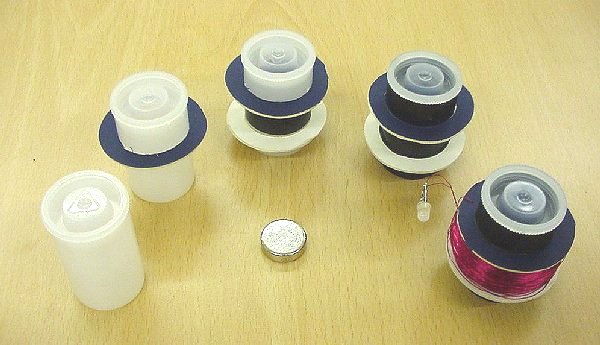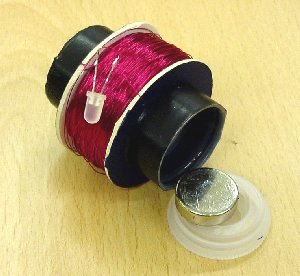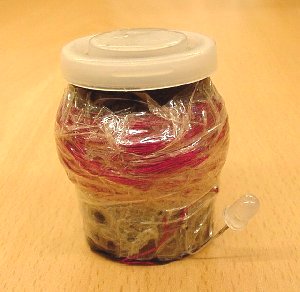
Picture showing various stages of the film can generator. Shown in the middle is one of the small (but strong) magnets.
Note: for details of talks and workshops on this topic click here:
talks and workshops
The very simple, but effective generator described below is the (lateral thinking) result of a number of more sophisticated designs I have been investigating for my NESTA fellowship. It shows in a very simple, clear and wonderfully engaging way the fundamentals of electricity generation.
The generator is made from a coil of wire (about 500-1000 turns) wound around the outside of a plastic 35mm-film can. The two coil ends are connected to an LED. A magnet is then placed in the can and the lid snapped back in place. (Note: the magnets need to be the very strong - Rare Earth Neodymium type). All you need to do to create electricity and light the LED is shake the film can !!

Picture showing various stages of the film can generator. Shown in the middle is one of the small (but strong) magnets.
MAKING THE GENERATOR
Although you can simply wind the coil directly around the plastic film can (see picture of the first prototype) it is neater and easier to make a simple bobin to wind the coil round. Here's how to do it:
Step 1
Find a 35mm plastic film can and remove the lid. Cut out two cardboard circles about 50mm diameter and cut out their centres (33mm diameter hole) so that they fit snugly onto the canister. Space the two circles about 1cm either side of the center of the can. Wind on a few turns of insulation tape on to the can, either side of the cardboard to hold them in place.
Step 2
Use the cardboard circles as a bobbin (or former) on which to wind the coil. Wind on 500 to 1000 turns of thin, insulated copper wire. Add a layer of sellotape to keep them from un-winding. Remember to leave about 10cm or so of wire free at each end.
Step 3
Scrape off some of the insulation (say 5mm or so) from the ends of the wire (using sandpaper) and connect to the LED (it does not matter which way round). Solder the connections if possible. Use some sellotape to secure the wire and LED to the bottom of the can.
Step 4
Pop a small (but powerful) magnet into the can and snap the lid back on. Hold the can between thumb and forefinger at the two ends of the can (with thumb or forefinger on the lid to stop it coming off !) and shake. The LED will light !!

Close up of the shake-a-gen (a 'thousand-turner')
WHAT TYPE OF BULB SHOULD I USE ?
Almost any LED (light emitting diode) will work well in this design because they take very little current (about 0.01A). LED's can be obtained from any electronic component store (e.g. such as Maplins) or perhaps scrapped from an old radio or toy that contains one. A low voltage bulb may also work in this design (say a 6V at 0.01 Amp. bulb but most very low voltage bulbs (e.g. 1.25V) won't work however because they take too much current).
Click here to find information about LED's
WHAT TYPE OF MAGNET SHOULD I USE ?
In general the stronger the magnet the better. There are many suppliers of suitable magnets for example; Eclipse, Maplin and Axminster Tools etc. and are also available from most hardware stores. As long as the magnet is strong and small enough to freely move inside the can (as you shake it) it will/should work. Amazing magnets sell the best magnets I have used so far type D250H fit a 35mm film can perfectly (they are extremely strong having a surface field strength of about a Tesla):
Amazing Magnets web site
PARTS LIST AND TOOLS
Sellotape and insulation tape
fine(ish) sandpaper
Cardboard
Reel (about 50m or so of insulated wire needed) of enamelled copper wire (size is not critical but 30 SWG or about 0.3mm diameter will do fine)
Magnet: Amazing magnets type D250H fit a 35mm film can perfectly (or failing that try magnets at eg. Axminster Tools: 128475, or Eclipse Magnets: E822, or Maplins: SF19V see web sites)
Any LED (e.g. Maplins: WL84F and for the bi-colour LED (see below) Maplins: QY83E),
(you could try a torch bulb, see above note (6V, 0.06A))
Most of these parts can be obtained from a DIY store or from electronic shops such as Tandy or Maplins.
WINDING COILS
Winding 1000 turns of wire on a former is not easy. The worst thing is when you are 800 turns in and the wire from the reel starts to get all tangled and forms a birds nest ! Click below for details of how to make a bobin holder for the wire reel to stop this happening:
WIRE REEL HOLDER
Web site information:
For details about magnets try:
http://www.mutr.co.uk
Amazing Magnets web site
https://www.axminstertools.com

The first prototype generator. Simply wind the coil around the can!
IDEAS FOR FURTHER EXPERIMENTS
1) Try varying the number of turns. Is it always true that the voltage goes up with number of turns for this simple gen ? What happens when the coil gets so large that most of it is no longer very close to the magnet ?
2) Try using different size magnets and also using more than one magnet (joined together) at a time. Do you get twice as much light with twice the volume of magnets ?
3) Does it matter how compactly the coil is wound along the outside of the can?
4) How about trying other forms of energy to power the device eg. wind or wave power?
Please see the article that Ellen McCallie and I have written about using a shake-a-gen to make electrical power from ocean waves:
starting to explore wave power
5) Can you build-in a moving switch to make the voltage direct (DC) instead of alternating (AC) (this is called a commutator) ?
6) with the magnet removed can you use the generator as a 'search' coil for detecting varying magnetic fields ? Try putting it near to a speaker playing load music, does the LED flash with the music ?
7) There is a type of LED called a bi-colour LED (Maplins code: QY83E). These devices are actually two LED's contained within one package; a red and a green LED. The two LED's are wired so that one will light (say the red one) when connected one way round and the other (the green) will light when the connections are reversed (or the power is reversed). If you wire this type of LED to the generator it is rather nice, as the red will light when you shake the magnet one way and the green will light when the magnet falls back. If the magnet are small they can twist and turn inside the can and so the light changes colour in an interesting way. The changing colour of the LED shows that this simple generator is in fact an AC generator (see above).
8) STORING THE ENERGY FROM THE GENERATOR
rectifier and storage device - a simple circuit to make a DC voltage from the gen and store the energy.
NOTE: never go near to mains powered devices of any kind with this apparatus
DONT PLAY WITH THE MAINS POWER ELECTRICITY - IT KILLS
Acknowlegments
I would like to thank NESTA for the continued support with my Fellowship which is giving the valuable space, time and resources to follow up ideas and most importantly to dream up new ones. I would also like to thank Chris from the staff of the university pharmacy who save up bags of surplus film cans for me! Finally, I would also like to thank Angie (funky chicken) Birch from the Rough Science Team for giving me a load of those 'damn strong' magnets.
Please note that this article has been published in Physics Education
see Physics Education webpage
link to 6 gens page
(Please reference this article if using contents elsewhere)
THE CREATIVE SCIENCE CENTRE
home | diary | whats on | CSC summary | latest news